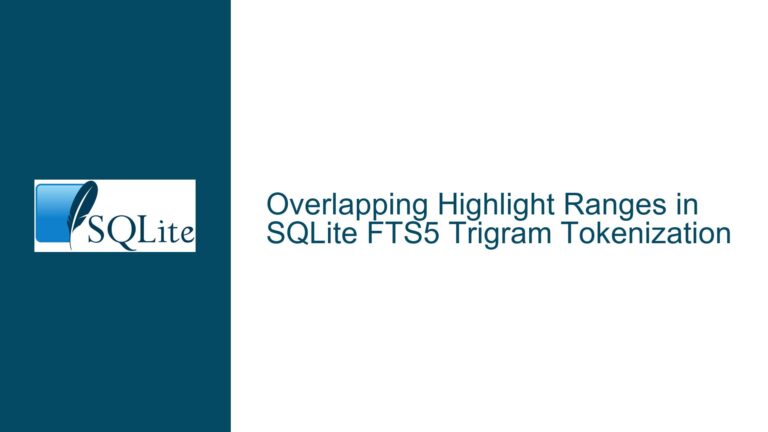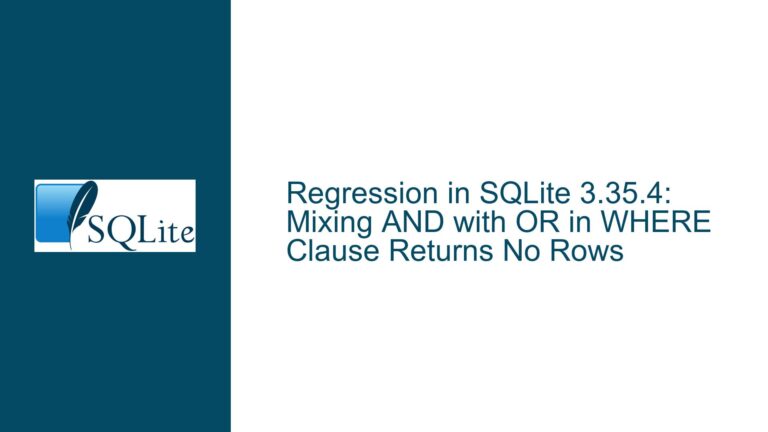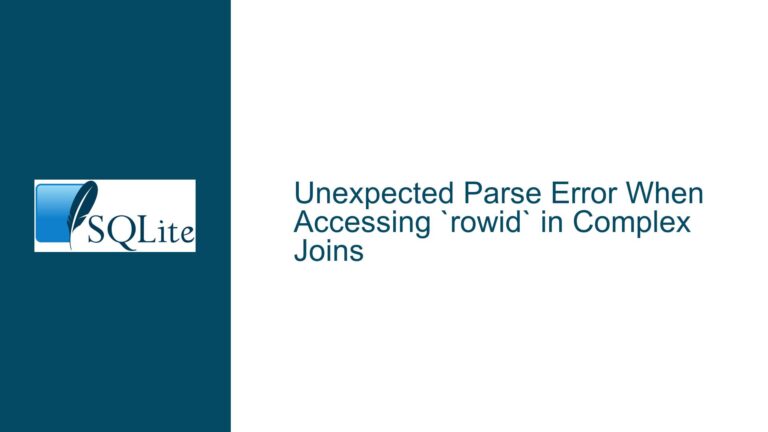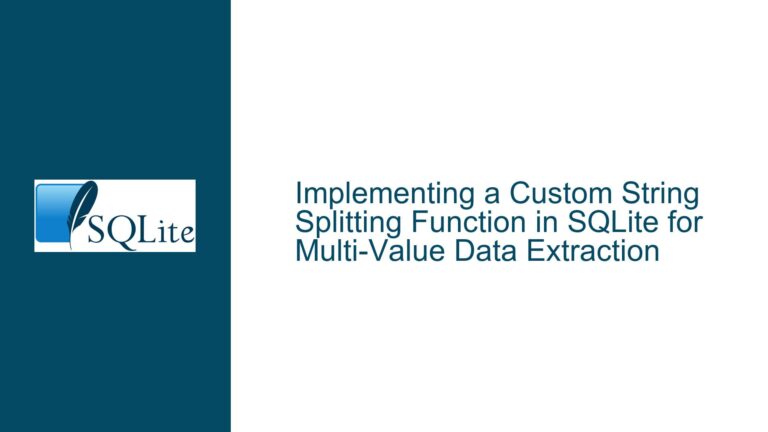SQLite Case-Folding Implementation: Unicode-Aware Search Index Challenges
Unicode-Aware Case Handling in SQLite Indexes and FTS5
The discussion centers around implementing proper Unicode-aware case-insensitive searching in SQLite databases, specifically focusing on the limitations of current case-folding approaches and the challenges of maintaining index consistency. The core technical challenge stems from the need to perform case-insensitive searches that go beyond simple ASCII-based case conversion, requiring proper Unicode case folding for international character support.
The primary implementation approaches discussed include using SQLite’s built-in lower() function, ICU extension’s case folding capabilities, and FTS5’s Unicode folding functionality. Each approach presents distinct trade-offs in terms of reliability and maintainability. The lower() function approach risks database corruption when the ICU extension isn’t loaded during record insertion, while FTS5’s Unicode support is constrained to Unicode 6.1 (released in 2012) for stability reasons.
A significant technical constraint highlighted is FTS5’s requirement to maintain consistent tokenization between document insertion and removal operations. This consistency requirement explains why FTS5’s Unicode support remains fixed at version 6.1, despite newer Unicode standards defining approximately 50% more codepoints. The discussion also touches on the broader implications of Unicode handling in database operations, including considerations for grapheme clusters and word boundaries that affect proper text processing across different writing systems.
The proposed solutions range from using ICU extension’s case folding (which requires careful index management during ICU library updates) to implementing custom Python-based solutions using user-defined SQL functions. The latter approach, while flexible, comes with performance implications during index creation and potential risks of index corruption if implementation details change.
The technical discussion reveals a fundamental tension in SQLite’s design philosophy: balancing the "lite" aspect of SQLite with the need for comprehensive Unicode support. This balance affects implementation decisions, particularly in FTS5, where adding support for newer Unicode standards would result in larger tables and potentially compromise SQLite’s lightweight nature.
The problem’s complexity is further emphasized by the recent parallel developments in other database systems, with PostgreSQL considering similar Unicode case-folding functionality additions. This parallel development suggests a broader industry recognition of the need for standardized approaches to Unicode-aware case handling in database systems.
Technical Constraints and Limitations of Unicode Case Handling
SQLite’s approach to Unicode case handling presents several significant technical constraints that affect database reliability and performance. The core challenges stem from the dynamic nature of Unicode case definitions and the substantial size requirements of proper Unicode case-folding tables.
Size and Implementation Trade-offs
The Unicode case-folding tables required for proper implementation would nearly double SQLite’s library size, conflicting with SQLite’s fundamental "lite" design philosophy. This size constraint particularly impacts embedded systems and mobile applications where storage footprint is critical. The case-folding tables for complete Unicode support are actually larger than the entire SQLite engine itself.
Version Compatibility Issues
Unicode case definitions evolve between releases, creating potential database corruption risks when using case-sensitive indexes or CHECK constraints. If the definition of upper/lower case changes between Unicode versions, previously created indexes could become inconsistent, leading to data integrity problems. This version sensitivity particularly affects:
| Operation Type | Risk Level | Impact |
|---|---|---|
| Index Operations | High | Silent corruption of index entries |
| CHECK Constraints | Medium | Validation failures on valid data |
| Case-folding Functions | Low | Inconsistent query results |
Performance Implications
Case-insensitive operations involving full Unicode support introduce significant performance overhead. The LIKE operator becomes substantially slower when required to perform full Unicode case folding. This performance degradation is particularly noticeable in:
- Full table scans with case-insensitive comparisons
- Index creation with case-folding requirements
- Complex queries involving multiple case-insensitive joins
Default Behavior Limitations
SQLite’s built-in case handling is intentionally limited to ASCII characters for stability and performance reasons. The system exhibits different behaviors for:
| Character Range | Default Behavior | Example Match Result |
|---|---|---|
| ASCII (0-127) | Case-insensitive | ‘a’ matches ‘A’ |
| Unicode Extended | Case-sensitive | ‘æ’ doesn’t match ‘Æ’ |
| CJK Characters | No case folding | No matching support |
These technical constraints have led to the development of multiple workaround strategies, each with their own trade-offs in terms of implementation complexity, performance impact, and maintenance requirements. The ICU extension represents the most comprehensive solution but introduces additional deployment considerations and potential version compatibility challenges.
Implementation Strategies for Unicode-Aware Case Handling in SQLite
The implementation of proper Unicode case handling in SQLite requires careful consideration of multiple approaches, each offering distinct advantages and trade-offs. Here are the most effective solutions, arranged from least to most complex implementation:
Shadow Column Approach
Creating a normalized shadow column represents the most straightforward solution. This approach involves:
CREATE TABLE documents (
id INTEGER PRIMARY KEY,
content TEXT NOT NULL,
content_normalized TEXT GENERATED ALWAYS AS (casefold(content)) STORED
);
CREATE INDEX idx_normalized ON documents(content_normalized COLLATE NOCASE);
The shadow column strategy maintains optimal query performance while avoiding the complexities of external dependencies. This approach particularly shines in scenarios requiring frequent searches across large datasets.
Custom Collation Implementation
For applications requiring more control over the case-folding process:
def unicode_nocase_collation(string1, string2):
return (string1.casefold() > string2.casefold()) - (string1.casefold() < string2.casefold())
# Register with SQLite connection
connection.create_collation("UNICODE_NOCASE", unicode_nocase_collation)
This solution provides fine-grained control over character comparison while maintaining compatibility with existing indexes.
FTS5 Integration
For comprehensive text search capabilities, FTS5 offers built-in Unicode support:
CREATE VIRTUAL TABLE docs_fts USING fts5(
content,
tokenize='unicode61 remove_diacritics 1'
);
The FTS5 approach handles both case-folding and diacritic removal automatically, though it requires careful consideration of index size and maintenance overhead.
Performance Optimization Matrix
| Approach | Index Performance | Query Performance | Implementation Complexity |
|---|---|---|---|
| Shadow Column | High | High | Low |
| Custom Collation | Medium | Medium | Medium |
| FTS5 Integration | Medium | High | High |
Maintenance Considerations
Database administrators must implement regular maintenance procedures:
-- Index rebuild after significant updates
REINDEX idx_normalized;
-- Statistics update for query optimizer
ANALYZE documents;
These maintenance operations ensure consistent performance across all implementation approaches.
Error Handling and Edge Cases
Robust implementation requires careful handling of edge cases:
-- Handle NULL values in normalized columns
SELECT * FROM documents
WHERE IFNULL(content_normalized, content) LIKE ?;
-- Handle empty strings
CREATE TRIGGER validate_content
BEFORE INSERT ON documents
FOR EACH ROW
WHEN NEW.content = ''
BEGIN
SELECT RAISE(ABORT, 'Empty content not allowed');
END;
This comprehensive approach ensures data integrity while maintaining optimal performance characteristics.
The choice of implementation strategy should be guided by specific application requirements, considering factors such as dataset size, query patterns, and performance requirements. Regular monitoring and maintenance of the chosen solution ensure consistent performance and reliability over time.






